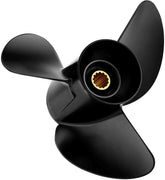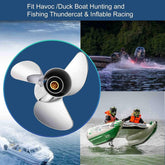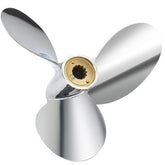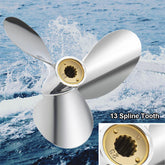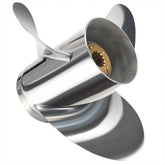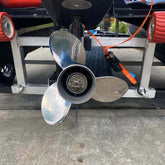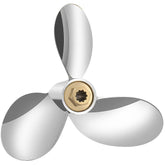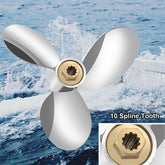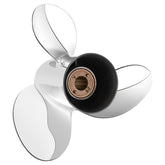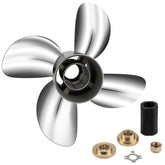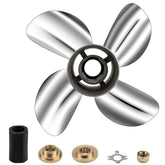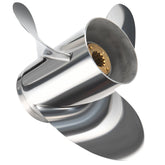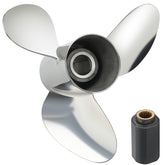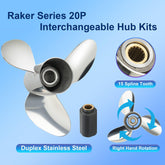Boat Propeller Calculator — How to Choose Pitch, Diameter & Blade for Your Outboard
Choosing the right propeller for an outboard is equal parts science and fieldcraft. You need the numbers — pitch, diameter, blade count, slip — but you also need practical testing and an understanding of how your particular hull, load and typical use interact. This article gives you a real-world prop calculator workflow (with formulas you can use right now), explains why those numbers matter, and shows how to use them to pick a prop that gets your boat on plane faster, cruises cleaner, and hits WOT in the recommended RPM band.
I’ll also weave in product and manufacturing details from VIF Marine — a fast-growing prop supplier that offers both stainless and aluminum outboard props, modern CNC/automated production, U.S. warehousing and a 180-day warranty — so you can evaluate cost-effective options while doing proper testing. This isn’t generic marketing copy; it’s a field guide you can use the next time you’re on the water tweaking props.
Why a propeller calculator matters (and why you can’t skip the field test)
There are two kinds of boater mistakes when it comes to props:
-
Choosing a prop off a spec sheet and never testing it in real conditions. Result: wrong WOT RPM, poor acceleration, and regret.
-
Guessing by feel and settling for “close enough.” Result: lost fuel economy and slower boat.
A propeller calculator gives you an objective baseline: theoretical speed for a pitch at a given RPM, and slip percentage when compared to real-world GPS speed. That’s the number you tune to. But calculators alone won’t fix trim, hull fouling, transom height, or a bad hub — those need testing. Put simply: calculator = hypothesis; on-water testing = experiment.
The core props math (the formulas you’ll actually use)
You don’t need to be a naval architect to use a prop calculator. There are three compact, practical formulas that tell you what you need:
1) Theoretical speed (mph)
This is the distance that a prop would travel in one revolution if it were moving through a solid (it’s theoretical — water complicates things).
Theoretical speed (mph) = (Pitch in inches × RPM) / 336
Why 336? It’s the conversion factor from inches per minute to miles per hour (12 inches/ft × 5280 ft/mile ÷ 60 minutes/hour ≈ 336).
2) Propeller slip (%)
Slip measures how much of the prop’s theoretical travel is being “lost” to water inefficiencies. Lower slip is generally better for planing hulls; higher slip suggests mismatch.
Slip % = (1 − (Actual speed / Theoretical speed)) × 100
Example: If your prop pitch is 19", your WOT RPM is 5,000 and your GPS top speed is 46 mph:
-
Theoretical speed = (19 × 5000) / 336 ≈ 282,000 / 336 ≈ 83.9 mph
-
Slip = (1 − 46/83.9) × 100 ≈ (1 − 0.548) × 100 ≈ 45.2%
That’s a crazy-high slip (typical for a displacement hull or totally wrong pitch). Real planing hulls typically fall in the ~10–25% slip range once properly matched.
3) Pitch adjustment logic (practical tuning rule)
If your engine has a recommended WOT RPM band from the manufacturer, tune pitch so the engine reaches that band when the boat is lightly loaded and properly trimmed.
-
WOT RPM too low (engine lugging): reduce pitch (go down a couple of inches).
-
WOT RPM too high (engine over-revving): increase pitch (go up a couple of inches).
Small pitch changes have surprisingly noticeable effects. If WOT is off by more than 300–400 RPM, change pitch.
A practical on-water workflow (do this the next time you test props)
-
Clean the hull, set fuel load, and load the boat with typical passengers/gear. Don’t test with an empty boat unless you always run that way.
-
Check transom height — make sure your engine is at or near factory recommended height. Trim and trim tabs are set neutral.
-
Run to WOT in calm water, record GPS ground speed and the tachometer RPM. Repeat the run 2–3 times to average.
-
Compute theoretical speed for your prop’s pitch and RPM, then calculate slip.
-
Compare slip to what you expect for your hull type: planing bass boats should be lower (10–18%), heavier pontoons/tri-toons higher (20–30%).
-
If WOT RPM is outside manufacturer recommendations, pick a prop with ±1 or ±2 pitch and re-test. Note changes in acceleration and plane time too (not just top speed).
-
For every test change, observe ventilation/cavitation: excessive ventilation means poor lower unit height or too much rake — don’t just throw a higher pitch at it.
This systematic approach takes the guesswork out of swapping props.
What the numbers actually tell you (translation guide)
-
High theoretical speed with low actual speed (big slip) → prop pitch is too high, or hull isn’t planing. Try lower pitch or check hull/trimming.
-
Actual speed approaches theoretical speed (low slip) → good match; top speed likely near maximum possible for that engine/hull combo.
-
Low top speed with WOT RPM high → pitch too low; engine overspinning, increase pitch.
-
Engine bogging and low RPM → pitch too high; reduce pitch.
Use the WOT RPM band the engine maker recommends as the authority. Aim to be inside that band at WOT with your typical load.
Choosing pitch: not always intuitive (real examples)
A few real-world examples help:
-
A 115HP 4-stroke on a 17-foot aluminum bass boat typically has a stock prop near 14×17. If you add heavy coolers and two adults, you might need a 14×15 or 13×17 to improve hole shot.
-
A 150HP center-console with heavy fuel and twin anglers might find a 3-blade stainless 15×19 is too tall when loaded; dropping to 15×17 improves acceleration and planing.
Those sample numbers are realistic starting points — exact values vary with hull shape and engine model.
Blade count, diameter and pitch: how they work together
-
Pitch controls theoretical speed (gearing).
-
Diameter equals how much water your prop is moving per revolution (bigger diameters carry more load at lower RPM).
-
Blade count / blade area affects how much bite you have. More blades = more bite and smoother thrust at low speeds, but slightly more drag at top end.
Common trade-offs:
-
A 3-blade prop of a given diameter and pitch will usually yield a higher top speed than a 4-blade of the same diameter and pitch.
-
A 4-blade increases low-speed thrust and planing ability at the cost of a small top-speed hit. That’s why many family/pontoon/loaded-boat owners prefer 4-blades.
Prop shaft and handedness: why rotation direction matters
Most single-engine outboards are right-hand rotation (turning clockwise when viewed from stern) — that rotation creates slight lateral force (prop walk) and affects handling at low speeds. Dual-engine boats often use counter-rotating props to balance out forces.
When using a prop calculator, handedness doesn’t change theoretical speed math, but it matters for handling tests: if your boat pulls to starboard or port at idle, that might be a prop-induced issue, not a hull one.
Cupping, rake and camber: the subtle geometry that fixes real problems
Beyond diameter/pitch/blade count, small shaping features profoundly change performance:
-
Cupping: small curl at the trailing edge of blades. Adds low-end bite and helps prevent ventilation — useful if you have cavitation at WOT or blow-out at top rpm.
-
Rake: the angle the blade tips are tilted toward the transom; high rake can lift the bow at speed.
-
Camber and skew: blade curvature and sweep that smooth vibration and improve cavitation resistance.
When your tests show ventilation or a twitchy ride, a prop with slightly more cup or different rake may fix it — sometimes better than changing pitch.
Propeller slip calculator — a simple spreadsheet you can build in 5 minutes
Here’s a minimal spreadsheet layout that you can make in Excel/Sheets:
Columns:
-
A: Prop designation (e.g., 14×19 SS)
-
B: Pitch (in)
-
C: Measured WOT RPM
-
D: Theoretical speed (formula = (B*C)/336)
-
E: GPS speed (mph)
-
F: Slip % = (1 − E/D) × 100
-
G: Notes (trim, load, temperature, prop material)
Fill rows for each prop you test and you’ll see which prop gives meaningful reductions in slip and where your WOT RPM hits the engine band best.
Material choice: aluminum vs stainless — calculator implications
From the calculator perspective, material doesn’t change the math, but it changes achievable outcomes:
-
Stainless steel props can be made with thinner, more efficient blade sections — they often yield higher top speed (a few percent) and better acceleration because they push more effectively for the same diameter/pitch. That means stainless often lowers slip for a given pitch/RPM.
-
Aluminum is cheaper and more forgiving in a strike (it tends to bend rather than damage the gear case), but the thicker blades mean more drag, potentially higher slip and slightly lower top speed.
If you’re testing with aluminum props and then swap to stainless, re-run your WOT/RPM tests — the change in slip is real and measurable.
VIF Marine: how factory-level production fits into the prop calculator workflow
A lot of folks want “brand advice,” but what helps more is a supplier that lets you try multiple props at reasonable cost. That’s where VIF Marine comes in.
Why VIF matters to the prop-testing boater
-
Price: VIF’s model is factory-direct. For many stainless props you’ll see prices ~40–50% below Mercury/Yamaha retail — which means you can test multiple pitches or blade counts without bleeding cash.
-
Manufacturing: automated casting, 5-axis mold machining, and robotic CNC finishing mean VIF props are produced to consistent pitch/diameter tolerances — you won’t be guessing whether the factory cut the pitch right.
-
QC & testing: dynamic balancing, CMM (coordinate measuring machine) pitch checks, salt spray tests — the kinds of steps that actually matter when you’re fine-tuning slip and RPM.
-
Logistics: U.S. warehouses reduce lead time, which is helpful when you want to swap props the same week.
-
Warranty: a 180-day manufacturing defect warranty (replace/repair) gives confidence when testing multiple units.
How to use VIF in your calculator workflow
-
Buy two VIF props: the OEM-recommended pitch and one ±1 pitch. Use the aluminum option if you’re budget constrained, or stainless if you want closer-to-OEM performance.
-
Run the on-water workflow above. Compare slip and WOT RPM with both props. If the stainless shows lower slip and brings RPM where you want it, you’ve likely found a keeper without the OEM price tag.
(If you want, I can insert the exact VIF product ranges in a spec table — MEGARA, YANTA, SEMA or POLASTORM series — but you’d need to confirm which exact rows from your product sheet you want displayed.)
Real-world examples and case studies
I’m going to walk you through two condensed case studies I’ve seen in the shops and on forums — real situations where the calculator approach fixed the problem.
Case 1 — A family deck boat that never seemed to plane
Boat: 19’ deck boat, single 150HP outboard, 4 adults + gear.
Symptoms: slow to plane, engine revs below recommended WOT band (max RPM at WOT ~4,300; recommended 5,000–6,000).
Diagnosis using calculator: theoretical speed for stock 15×21 at 4,300 RPM was far higher than GPS, but slip was 35% and WOT RPM was low → pitch too high.
Solution: install 15×17 (–4 pitch), retest — WOT RPM now 5,350 (in band), GPS improved, slip down to ~14%. Acceleration and planing dramatically improved.
Case 2 — Angler wants top speed but keeps topping RPM
Boat: 17’ bass boat, 200HP single. Owner wants more top end. Current prop: 17×21 stainless, WOT RPM hitting redline early and engine over-revving with unhappy gearbox temperature.
Diagnosis: WOT RPM too high → pitch too low. Theoretical speed and actual speed showed low slip but RPM too high.
Solution: Go to 17×23 (increase pitch 2"). WOT RPM now in the recommended band, and top-end speed increased with stable slip around 12%.
These examples are common: one tends to be too tall a pitch for load; the other too small.
Practical tips: what to log during tests (so the numbers are useful)
Every time you test, log:
-
Boat weight and distribution (people, coolers, fuel level)
-
Water temperature (affects engine power and drag)
-
Wind and chop conditions
-
Transom height and trim tab settings
-
Prop model and material
-
Tachometer reading at WOT and GPS speed
-
Notes on feel: planing time, cavitation, vibration
Keep the spreadsheet. After a season, you’ll have a personal map of what works for your hull, engine and use.
Common pitfalls — don’t let these trip you up
-
Testing in different conditions: Don’t decide on a prop on a windy, choppy day. Test in calm water or note the conditions.
-
Using peak RPM alone: RPM matters, but slip and acceleration do too. A prop that gets RPM but makes the boat boat-hook or ventilate is not a win.
-
Ignoring gearcase/trim: Engine trim and gearcase height can make a small prop change look like a huge improvement — make sure trim is set consistently.
-
Mixing hub types and ignoring fitment: splines, thrust washers and hub styles vary. A prop that fits physically might not behave identically across different hub systems.
Prop repair and spun hub detection (what the calculator can’t spot)
The calculator shows performance, not mechanical failure. Here are quick checks:
-
Spun hub symptoms: engine revs but little thrust under load; inability to reach planing speeds. This is a mechanical slip inside the prop hub; change the hub or prop.
-
Bent blades: vibration at cruising RPM, reduced top speed. Some straightening possible but many shops recommend replacement for stainless.
-
Hub wear: irregular slip behavior and changes in top speed over time.
If you suspect mechanical problems, fix the hardware before pursuing more prop testing.
Image suggestions (for the blog or social sharing)
-
Photo: prop cutting a wake at midday (hero image). Alt: “Boat propeller cutting water at speed.”
-
Diagram: pitch vs diameter illustration with labeled example (14×17). Alt: “Propeller pitch and diameter explained.”
-
Spreadsheet screenshot: sample prop test log showing pitch/RPM/GPS/slip. Alt: “Prop test spreadsheet example.”
-
Side-by-side: aluminum vs stainless props on workbench. Alt: “Aluminum vs stainless outboard propellers.”
-
VIF factory shot: CNC machining center or prop dynamic balance machine. Alt: “VIF propeller CNC machining and quality control.”
Frequently Asked Questions (practical, short answers)
Q — How do I know the pitch of my current prop?
Look at the casting or stamping on the prop hub — common notation is Diameter × Pitch (e.g., 14×17). If unreadable, check engine manual for stock prop spec or measure with a chart.
Q — What’s an acceptable slip %?
For planing boats, 10–25% is common. Heavy displacement hulls have higher slip. Compare against similar boats for reference.
Q — Should I always use stainless for performance?
If you want max efficiency, top speed and durability in saltwater, yes — stainless is generally superior. But aluminum is cheaper and can protect the lower unit in a strike.
Q — Is a 4-blade always better for heavy boats?
Not always, but generally yes for acceleration and planing under load. It trades a small top speed for improved runability and lift.
Q — Can a prop change fix my engine overheating?
Sometimes. A prop that’s too tall can overwork an engine at low RPM ranges. But overheating also results from cooling system failures — have both checked.
Q — How many pitch inches should I change at a time?
Start with ±1–2 inches. Extreme jumps cause big changes that are hard to reverse quickly.
Q — What’s the best way to test pitch swaps?
Use the spreadsheet method: keep load constant, test multiple runs, average the numbers, and compare slip & WOT RPM.
Final, practical recommendation
If you’re serious about getting the most from your outboard:
-
Use the prop calculator as your starting point.
-
Execute the on-water workflow: same load, same trim, GPS + tachometer.
-
Buy test props smartly: if you only want to try one pitch difference, look for cost-effective stainless options (VIF offers good value) or a budget aluminum spare.
-
Keep a simple spreadsheet — it pays dividends over a season.
Numbers don’t lie, but numbers alone don’t tell the whole story. Match the calculator with consistent on-water testing, and you’ll find the prop that gives you the best mix of acceleration, planing, top speed and economy.


